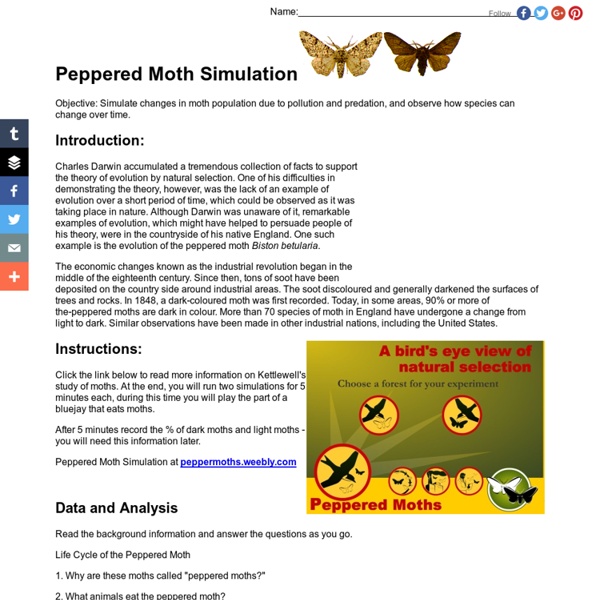Peppered Moth Simulation
Name:______________________________________________ Objective: Simulate changes in moth population due to pollution and predation, and observe how species can change over time. Introduction: Charles Darwin accumulated a tremendous collection of facts to support the theory of evolution by natural selection. The economic changes known as the industrial revolution began in the middle of the eighteenth century. Instructions: Click the link below to read more information on Kettlewell's study of moths. After 5 minutes record the % of dark moths and light moths - you will need this information later. Peppered Moth Simulation at peppermoths.weebly.com Data and Analysis Read the background information and answer the questions as you go. Life Cycle of the Peppered Moth 1. 2. 3. 4. 5. 6. Impact of Pollution 7. 8. 9. 10. 11. 12. Kettlewell's Experiments 13. 14. 15. 16. 17. 18. 19. 20. Birdseye View 21. Final Analysis 22. 23. 24.
KidWings
The driving force for molecular evolution of translation
Chpt 3 One Wrong Letter
Earth Day Curriculum Resources, Grades K-5
By Phil Nast, retired middle school teacher and freelance writer Found in: Science, PreK-2, 3-5 Explore new and review familiar ways to live responsibly with these lessons, projects, activities, and games for grades K-5. Lesson Plans Conserving Water through Art! PDF, 127 KB, 5 pgs.) Healthy Earth, Sick Earth ( PDF, 517 KB, 13 pgs.) Comparing Light Bulbs Students in grades K-8 compare compact fluorescent and incandescent light bulbs to measure the difference between being energy-efficient and energy-wasteful. Draft-O-Meter Students in grades K-8 learn an easy technique to measure the presence of drafts in their homes and classrooms. Build a Pizza Box Solar Oven Students in grades K-12 make a simple solar oven using a pizza box that gets hot enough to warm up cookies and other treats, like s'mores. Energy Detectives (3 Activities) Students in grades 5-8 search their classroom for energy connections and record the ways they use energy throughout a typical day in an energy detective journal. Video
Extraordinary Adaptation
Sustainable Table | Genetic Engineering
Genetic engineering (GE) is the modification of an organism’s genetic composition by artificial means, often involving the transfer of specific traits, or genes, from one organism into a plant or animal of an entirely different species. When gene transfer occurs, the resulting organism is called transgenic or a GMO (genetically modified organism). Genetic engineering is different from traditional cross breeding, where genes can only be exchanged between closely related species. With genetic engineering, genes from completely different species can be inserted into one another. For example, scientists in Taiwan have successfully inserted jellyfish genes into pigs in order to make them glow in the dark. What are genes? All life is made up of one or more cells. During genetic engineering processes, specific genes are removed from one organism and inserted into another plant or animal, thus transferring specific traits. GE Crops Some GE crops are actually classified as pesticides. GE Animals
Celebrate Earth Day!
Grades K – 2 | Lesson Plan | Standard Lesson Digging Up Details on Worms: Using the Language of Science in an Inquiry Study This lesson, in which students research worms in order to create a classroom habitat, incorporates reading and writing across content areas as well as math and science activities. How Does My Garden Grow? Writing in Science Field Journals Students plant a garden and study its growth using the inquiry process of questioning and exploring. Protecting Our Precious Planet: Sharing the Message of Earth Day Students discover that they can make a world of difference when they participate in the online Earth Day bag program. Grades 6 – 8 | Lesson Plan | Standard Lesson Persuasive Essay: Environmental Issues How can we convince others to agree with us on important issues? Grades 6 – 8 | Lesson Plan | Unit Let It Grow: An Inquiry-Based Organic Gardening Research Project Grades 7 – 9 | Lesson Plan | Unit Finding Solutions to Food Waste: Persuasion in a Digital World
Animal Farm Episode 1, Part 3 of 10
Previous Posts - Ms. Hastings Science & Social Studies
Today we read about the difference between Work and Power and we also watch the two corresponding Brainpop.com videos After our reading and videos students were given the option to create a song or draw a cartoon to show what they learned about work and power. Inclined Plane Lab - 36 & 37 Today we completed a lab over inclined planes. As an analysis of their data I let them choose if they wanted to graph the average distance traveled for each of the different ramp heights or if they wanted to graph the farthest trial for each height.As a conclusion I had them answer the following three questions below their graph.1. Forces Gizmo : page 35 Today we completed a Gizmo called Force and Fan cars. As a class we completed the Gizmo and filled in the appropriate information. Forces Haiku : page 34 After discussing forces for the past few days I asked the kids to write me a haiku over the topic. Forces Foldable : page 33 Underneath each of the words we describe what type of force it was. Mass vs.
Related:
Related:



